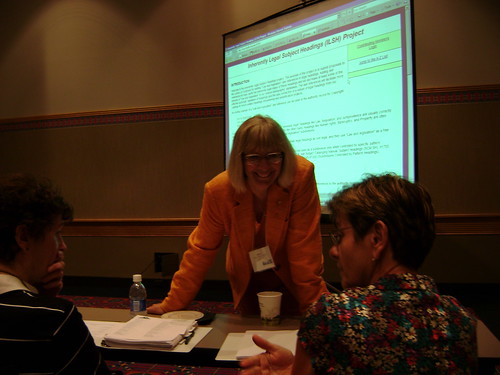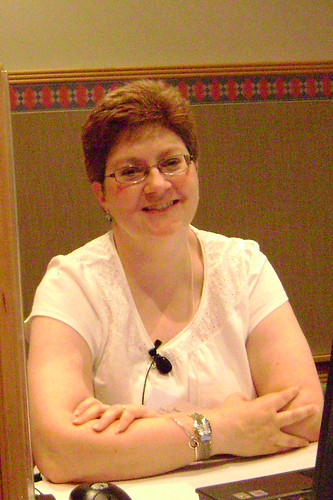- Richard M. Jost, University of Washington, Gallagher Law Library
- Mary Jane Kelsey, Yale Law School, Lillian Goldman Library
- Julie Loder, Vanderbilt University
- Debra Moore, Cerritos College
This session was a great way to get a taste of four of the major "discovery" products in a vendor-neutral setting. An excellent comparison of the features of all four platforms was compiled by the moderator, Keiko Okuhara of the University of Hawaii, and is available from the AALL handouts page at http://programmaterials.aallnet.org.
Mary Jane Kelsey spoke first about her experiences with Encore, Innovative Interfaces' (III) entry into the faceted browser market. They were development partners for Encore, and so were involved with its design from the beginning of the project.
- Their goals for implementing Encore included improving the user experience, increasing their return on their investment in the ILS and cataloging, maintaining a credible Web presence, and bridging the gap between the Law and University OPACs (the main library is currently on Voyager).
- As a current III customer, setup was pretty much plug-and-play, though increasing customization is available. Encore will also work with non-III systems, but the data is not displayed in real time.
- Encore displays a Google-like single search box. (A link to perform an index search is present on subsequent pages after the main search page.) Results are relevancy-ranked, with journal titles and electronic resources "pushed" to the top of the list; the latter are Yale's customizations to the ranking algorithm.
- Book jackets are shown at both the results and individual record level. Version 2.0 of Encore also features images from Yahoo "Safe Search" – though Mary Jane found some of those images not so "safe!"
- A built-in spell-check validates against the database to prevent dead-ends (though this sometimes gives odd results; for example, a search on "voter fraud" responds "do you mean violin fraud?").
- She finds the subject facts very useful; the ability to refine by tag includes a tag cloud displaying relative font sizes.
Debra Moore of Cerritos College presented their experiences with SirsiDynix's Enterprise Portal Solution (EPS) interface. They had not intended originally to implement a discovery platform, but they needed to migrate systems anyway and found funds available to make the switch, so they went ahead with EPS as their new interface for the new system.
- EPS is intended to be a total portal to the library, not just to its resources. It is built on a proprietary software system that allows the library to create content modules (called "rooms"). The library can customize the design of each "room" within limited parameters and can select which resources appear in each "room" (for example, you could have a "psychology room" with links to your local or other OPACs, journal databases, Web searches, etc.).
- Her favorite things about the system are the links to reviews, book jackets, and RSS feeds, and how the built-in federated search results display. (However, it is necessary to purchase a third-party product, such as Serial Solutions' 360 Search, to implement federated search.)
- Her not-so-favorite things are the lack of authority control (e.g., a search on "movies" instead of "motion pictures" will retrieve nothing), the clunkiness of the "room builder" software, the lack of faceted search results (though this is under development by SirsiDynix as a separate product), and the speed of the system.
Julie Loder of Vanderbilt University presented an overview of ExLibris' Primo. As Yale was with III, Vanderbilt was a development partner with ExLibris for Primo, and did a soft rollout of their "DiscoverLibrary" in Spring 2008.
- Their underlying OPAC is actually Unicorn, with Primo sitting "on top." At present the use of the native catalog is still required for "My Account" functions and requesting.
- Primo works by building "pipes" to various collections (local OPAC, digital repositories, other databases) from which it extracts metadata into a standard form and "normalizes" it into an XML or PNX record.
- Primo features include faceted search to refine results, built-in federated searching, "did you mean" spell-check based on the library's catalog metadata, user tagging, and user-customizable views. A new feature, called "third node searching," converts remote compatible databases to a Primo-type index for faster searching.
- Initial feedback from their students has been positive, and the Primo interface is increasing the visibility of their TVNews Archives.
Richard Jost spoke last about the University of Washington's experience with WorldCat Local. (Note: the law library is not yet implementing WorldCat Local; these experiences are based on the main library.) Their implementation searches three catalogs and four article databases through one interface, including links to full text via an OpenURL resolver. WorldCat Local is still under development and not officially in release; UW is a beta partner on the project. They are still doing testing on design, the results algorithm, and request methods.
- Results can be sorted for the user: in UW's case they display UW libraries first, consortial libraries second, and WorldCat results last. If all UW/consortial copies are checked out, the system automatically brings up an ILL form. The ease in which items can now be requested from non-UW libraries has increased their borrowing significantly.
- Record results are displayed in a tabbed format so users can easily navigate to information about subjects, editions, libraries holding the item, item details, and reviews. WorldCat Local also offers faceted search, advanced search options and a built-in SFX-like link for articles.
- One drawback is that WorldCat Local does not contain any 3rd-party resources for which OCLC does not have a license to put in WorldCat, such as Early English Books Online and some microform sets. For those materials users must return to the current catalog. Richard mentioned he expected these materials would eventually be able to be included, but he was dependent on OCLC obtaining the relevant licenses.
The Q&A session afterwards revealed some interesting similarities and differences among the systems. Most systems highlight the user's search terms in results (though this wasn't always apparent from the PowerPoint screenshots). Most also allow libraries some control over how results display and are sorted. Interestingly, none of the libraries had done a multi-vendor evaluation before choosing their now-implemented platform: three of the four were development partners or beta test sites, and Cerritos College chose EPS because it came with their new SirsiDynix system. In response to a comment from the audience that faceting is breaking apart pre-coordinated data, all four librarians said they did not think anything was being lost by this. Instead, users are now finding things they never would have before, and faceting is an improvement over plain keyword searching.
This was a truly interesting look at the state of things to come in library interfaces, and the 75 minutes really flew by.


